|
Founded in
1842, as a joint stock bank, the Bank of Western India was reconstituted
in 1845, changing its name to the Oriental Bank and moving its head office
from Bombay to London. It was a move that appeared to cause some
consternation in Bombay, where, according to an article in The Times, the
shareholders were dissatisfied with the expense and conduct of their
London directors. However, it was an issue that appeared to fade, largely,
it would seem, not only because control resided in London rather than
Bombay, but also because there was much more available investment capital
in the former than the latter.
Of more importance, around this time was the Oriental Bank’s take-over, in
1849, of the Bank of Ceylon, which had been established in 1841,
incorporating the rights that went with joint stock banking in Ceylon.
More generally, it could be seen as part of a movement towards joint stock
banking in India, that both followed in the footsteps of joint stock
banking that began to emerge in England from around the middle of the
1820s, and that challenged the old agency houses in India.
Eventually, in 1851, it was granted a royal charter that enabled it to
undertake international exchange banking in the trading region east of the
Cape of Good Hope. In response to this new status it changed its name, yet
again, to the Oriental Bank Corporation. As the first of the Eastern
Exchange Banks to centre its activities on India, it would provide a
reference point for the other exchange banks that followed. Over the next
twenty-two years, in the wake of what was a long economic boom, in which
the Indian economy grew at a fairly rapid rate, it managed to establish a
very successful exchange banking operation that linked India to Britain
and to other parts of the globe. In so doing, it survived what was a major
crisis in credit in the middle of the 1860s.
In 1873, however, when the global economy began to turn downwards, the
Oriental Bank Corporation began to encounter new conditions that were
emerging as a result of the transformation in the world economy, which was
manifested by a fall in prices, a decline in the growth rate of foreign
trade, and a changing and at times unstable system of international
currency, that was highlighted by a series of international conferences
that sought to address the question of bimetallism. As the world sank
deeper into recession, the inability of producers to realize the value of
their commodities on the world market, saw machines lie idle and
industrial capital stagnate.
Indeed, it was not until the 1890s – somewhere between 1893 and 1898
depending on the country – that the global economy began to move once more
into an upward swing. Ironically, however, the Oriental Bank Corporation
was unable to profit what would prove to be a rapidly growing economy.
Indeed, while it had succeeded in building a very sound banking operation
through until the 1870s, it began to struggle from around 1878, ceasing to
operate in 1884 and then revived as the New Oriental Banking Corporation
in the same year. With the growth of other banks such as the Hong Kong and
Shanghai and the Chartered Bank the new organisation was never succesful
and it finally closed its doors in 1892.
 *
History courtesy of the AUSTRALIAN
NATIONAL UNIVERSITY via
Scripophily.com *
History courtesy of the AUSTRALIAN
NATIONAL UNIVERSITY via
Scripophily.com |
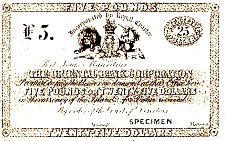
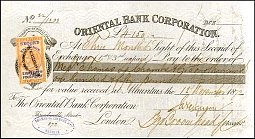
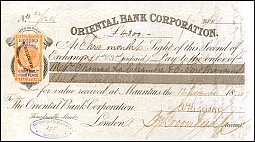
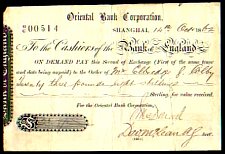
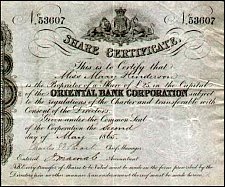
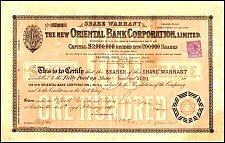
![]()